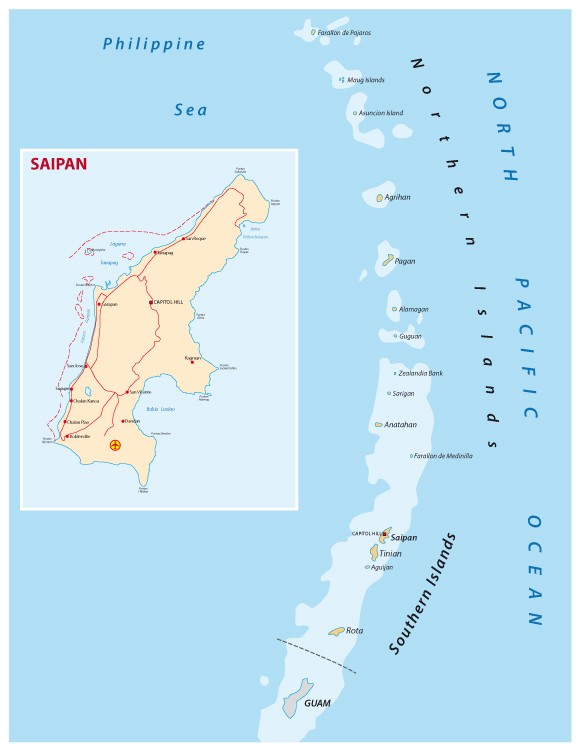Commonwealth of the Northern Mariana Islands Resources
An overview of telehealth resources available in the Commonwealth of the Northern Mariana Islands
Region Overview
The Commonwealth of the Northern Mariana Islands (CNMI) is an unincorporated United States territory located in the northwestern Pacific Ocean. It is a 300 mile-long archipelago made up of 14 islands. The islands of Saipan, Tinian, and Rota are the most populated islands. According to the 2020 US Census, the population of CNMI is 47,329 and about 92% (43,385) reside on the island of Saipan.
In 1975, the Covenant to Establish a Commonwealth of the Northern Mariana Islands in Political Union with the United States of America was signed, establishing CNMI as self-governing under the sovereignty of the United States.

Health Ecosystem
The healthcare system in the CNMI is a mix of public and private healthcare providers. The Commonwealth Healthcare Corporation (CHCC) is the public provider and oversees one hospital, emergency department, three municipal health centers, the Community Guidance Center, the Division of Public Health, behavioral health services, and ancillary services (a dialysis unit, a medical laboratory, pharmacy). There are five private clinics. As a territory, Medicare, Medicaid and CHIP funding are available to qualified residents.
Health System
Mixed public + private
- CNMI Commonwealth Healthcare Corporation (CHCC)
Private
- Independent providers and clinics
Health Insurance
Mixed public + private
- Medicaid and Medicare
- CHIP
- Private
Hospitals
Mixed public + private
- Commonwealth Health Center
Health Centers
Public
- Kagman Community Health Center
- Rota Health Center
- Tinian Health Center
- Community Guidance Center
- 5 private clinics
Telehealth Environment
Telehealth services in CNMI are mostly provider-to-provider consultations. Under development are programs and services in teledentistry, teleophthalmology, and teledermatology.
CNMI’s greatest challenges for sustainable telehealth services include:
- a lack of an accessible, robust, and affordable telecommunication infrastructure;
- reimbursement;
- change management; and,
- a need for a new payment structure and business models.
There is however a major opportunity to expand telehealth services in the CNMI. The CNMI’s off-island medical referral program is one of the highest-cost programs for the Commonwealth. In FY2019, the total cost for off-island medical referral services was $17.8 million whereas their annual budget appropriation is on average about $2 million. This expense does not include airfare, subsistence and hotel accommodations, or the health service cost. The off-island medical referral program is currently being restructured with plans to integrate telehealth to improve the facilitation of care coordination and potentially to reduce unnecessary off-island referrals.
Telehealth Readiness
Regional Leadership Support of Telehealth
The PBTRC Pacific Island telehealth concept paper was submitted and presented to the Pacific Island Health Officers Association (PIHOA) Board of Directors that consists of the Ministers and Directors of Health in the US Affiliated Pacific Islands (USAPI). During PIHOAs 63rd Executive Board Meeting, PIHOA Resolution 2018-63-01 was endorsed which called for unified support for the advancement of telehealth. This resolution prompted the leaders of the Micronesian Island Forum (MIF) to adopt Telehealth Resolution (No. 23-04) during the 23rd Micronesian Island Forum held in CNMI. The Resolution was signed by the Presidents and Governors of the USAPI to build regional and jurisdictional capacity and expansion of telehealth in the region. The PBTRC concept paper was included as an exhibit of the Telehealth Resolution (No. 23-04).
Telehealth Interest Survey
The Commonwealth Healthcare Corporation’s (CHCC) 2020 telehealth interest survey found increased interest in telehealth especially due to COVID-19 concerns. Although CNMI telehealth services are predominately provider-to-provider consultations they are developing teleophthalmology services and have passed teledentistry regulation in 2020. Read the Commonwealth Healthcare professions licensing and board regulations (PDF).
Current and Emerging Telehealth Initiatives
- CNMI has had more provider-to-provider telehealth consultations than provider to patient consultations. CHCC has participated in the SWINFEN telehealth network for receiving consultation support at no cost.
- The VA Pacific Islands Health Care (VAPIHC) provides telehealth services to veterans living on Saipan, Tinian and Rota.
- In 2020, the CHCC Family Care Clinic or Children’s Clinic offered telehealth visits to adhere to social distancing guidelines at the start of the COVID-19 pandemic.
- In 2021, CHCC was awarded an FCC Telehealth COVID-19 Round 2 grant in the amount of $522,722. The grant provided telehealth devices to expand outpatient telemedicine services, particularly for patients living on the more rural islands who would otherwise require air travel to access care, putting them at increased risk of contracting COVID-19.
- It is also recognized that behavioral mental health services through telehealth could increase access to care in CNMI.
- In 2022 CHCC has assumed the Medical Referral Office and the CHCC CEO has committed to creating a patient centered supported program with continuity of care and telehealth as a key component. PBTRC is working with the CHCC team to explore telehealth options.
